March 2018
On my way to the UK, I saw Verona, the only place in Veneto Province, but returned in March 15-18, 2019.
VERONA (pop260,000).
From the 3rd century BC, Verona was a Roman trade center. In the middle ages, it flourished under the Scala clan, both patrons of the arts and murderous tyrants. Between 1308-28, Verona conquered Padua and Vicenza and Dante, Petrarch and Giotto benefitting. The Scalas were run out in 1387 and Venice took control until Napoleon arrived in 1797. Shakespeare staged Romeo and Juliet here. In WWII it was a key location for Resistance interrogation and transit point for Italian Jews sent to Nazi concentration camps. Unesco listed, in the summer tourists flock here for a summer opera festival.
The old town is very sophisticated with many pedestrianized white limestone streets, expensive stores and restaurants, grand squares and lots of people, even in the winter.
Roman Arena. Seating 30,000 and built of white, light pink and dark pink limestone in the 1st century, it is now the host of the city’s famous opera in the summer.
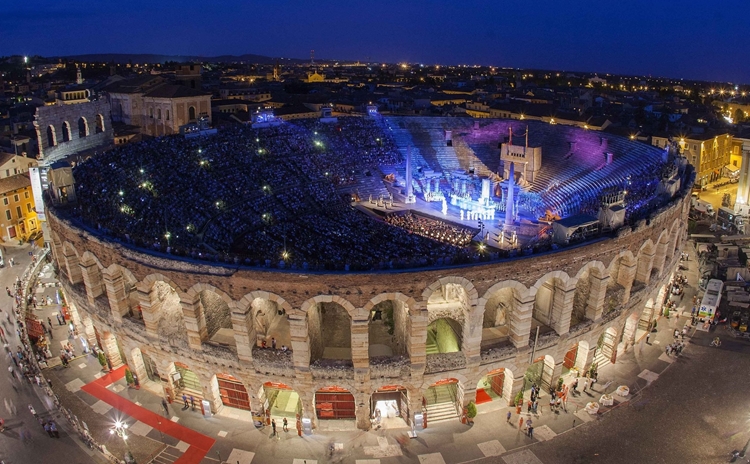
Museo di Castelvecchio. This imposing brick castle on the Adige River is now home to a typical museum with statuary, frescoes, medieval artifacts and paintings. I am tired of the art with its repetitive religious scenes.
Duomo. Built in the 12th century, the interior is completely frescoed, as are the other churches in town.
Although Verona is in the province of Veneto, it is only 30kms from Mantua and Brescia.
SOME OBSERVATIONS ON ITALY
I have written about these things before (go to Italy – General Information) but some things bear repeating.
1. My impression after seeing almost all of Italy is that Italians don’t like to follow rules – certainly not ones about driving, parking, paying taxes, etc. They are after my heart, as I don’t like following rules much either.
2. Driving. Italians have at least bad habits: a. Following too close. It is not rare to have a vehicle within a car’s length behind you even at high speed on the autostrada. This drives me crazy as it is so dangerous. I routinely put my hand up to try to get them to move back and if that doesn’t work (about half the time), I tap on my brakes. That drives them crazy as they don’t like to be told anything, I have now been swerved in front of and even had attempted to drive me off the road. b. Cutting corners. Because they drive so fast, they are always in your lane on corners. I can’t count the number of times, I have almost had to come to a stop on corners or how many near misses I have had. c. Speeding. I don’t think speed limits matter, certainly not on the autostradas where it is unlimited. One must be very careful on autostradas that are only two-lane as trucks passing are in the fast lanes, and they don’t care about cutting in front and don’t increase their speed when passing. The best way to deal with it is to drive at a good speed (over 120-130kms/hour) to pass all the trucks and don’t worry about the fast drivers. They will flash their lights, follow too close and make it seem that they have a right to that lane. d. Talking on their phone when driving. This is routine and there must not be a law against it (as there is everywhere in North America). But it creates distracted drivers. Italians love to talk.
3. Parking. Italy is the double-parking capital of the world. If you parked legally, you would never find a parking spot. Every Italian must have at least one car and parking on the street is their only option. I use unloading zones, sidewalks, handicapped parking, bus parking, just about everything illegal you can imagine. And so far have never gotten a ticket that I know of. But I have never double-parked. Nor have I ever paid for parking.
4. Italians are very nice people as a general rule. As opposed to the French who are simply rude if you don’t speak French, they go out of their way to give directions and help a tourist. And their level of English is much better than the French or Spanish.
Veneto March 15-17, 2019
Palazzo Grassi, Chioggia. This 4-story white plastered building was built in 1703-14 on the Vena Canal. From 1845-1970, it was the civil hospital and now since 2011, houses the Museum of Zoology Adriatica, full of specimens (all dead) – sharks, some tropical fish and primarily Adriatic fish. It discusses the loss of biodiversity. The museum is associated with the University of Padua.
However, the town of Chioggia is a beauty. Sitting on an island projecting into the Adriatic, it is full of canals crossed by lovely arched bridges, waterside restaurants and bars. There is an active fishing fleet and a yacht marina. It was 47kms north of Pompasano.
Battaglia Terme, In the NM “small town series”, this village outside Padua has no discernable interest. I was taken by Google Maps to the closed train station, drove by the unremarkable city hall, saw the Parish church, drove by the canal full of garbage and sat in a nice park with grass and trees.
Praglia Abbey. Teola. About 10kms west of Padua, I arrived at 3 pm just as the 20 monks started their chant in the choir of the church. It was lovely. The church is quite plain inside with a frescoed apse and dome. Vineyards surround the abbey.
VENICE (pop
The main city is an island bisected by the Gran Canal. Hundreds of small canals with tiny arched bridges are everywhere. Not many bridges cross the Gran Canal so try to see things on one side then cross over to the other side. The streets are occasionally wide but usually narrow and plazas common. On a Saturday in mid-March, the place seemed very crowded to me. I can only imagine what it would be like in the summer. It is possible to buy anything but ice cream, pastry, pizza/sandwich and knick-knack stores are a dime a dozen. There are also many high-end galleries/art stores and many specialty stores. I doubt that there are any bargains here.
Find your way around with a paper map (difficult) or Google Maps (good but there are so many tiny lanes that lose the GPS signal, even this can be challenging.
Tips for Venice
1. Getting There. Venice is an island reached by a causeway with a railway and a road. It is possible to drive into the very outside of Venice, but that is not meant to happen. Parking is limited and very expensive at about €27 per day. And Venice can only be walked. You cannot drive anywhere in the city. Lanes are very narrow and there are a million tiny canals with arched bridges over them. Park somewhere in Mestre, the city on the landside of the causeway. There is lots of pay parking in parkades but also pay street parking in the neighbourhood. Don’t pay any attention to the touts luring you into their parking lots. I parked in the McDonald’s/InterSpar parking lot about 600m away and walked to the Mestre train station (and had a parking ticket on return – I had no idea it was pay parking). Train tickets are €1.35 for the 9-minute ride to Venezia Santa Lucia train station at the west end of the island. On return, the station is Venezia Mestre. Do not take a bus. Trains leave every 5-10 minutes.
2. Venezia Unica City Passes. There are three types of museum/church passes for Venice. Note that St Marks is free. Buy at the train station in Venice (Venezia S Lucia) or online at www.veneziaunica.it and download the app. Nothing requires a reservation. A significant advantage is that you pass the ticket lines. When bought at the train station, get a piece of paper with a bar code that is scanned.
a. Museum pass. Gives access to 11 museums: Doges Palace, Correr Museum, National Archaeology Museum (enter from Correr Museum), State Monumentali of the Biblioteca Marciana, 18th Century Venetian Museum “Ca’ Rezzonico, Mocenigo Palace, Carlo Goldoni’s House, Ca’ Pesaro – International Gallery of Modern Art and Oriental Art Museum, Glass Museum (Murano Island), Lace Museum (Burano Island), Natural History Museum, Jewish Museum, Querini Stampalia Foundation. Admissions not included in the pass but are discounted are the Clock Tower and Fortuny Palace. €24
It does not include the Peggy Guggenheim Museum or dell’Accademia.
b. San Marco Pass. Includes Doge’s Palace and 3 civic museums, 3 churches (all have a €3 admission if done separately), Querini Stampalla Foundation, Teatro La Fenice (guided tour) and discounts on other museums, shows, shops, bars and restaurants. €38.90
c. All Venice Pack. Includes Doge’s Palace and 10 other Civic Museums, 16 churches, Querini Stampalla Foundation, Jewish Museum, Teatro La Fenice, Discounts as above. €49.90
I purchased the Museum Pass. Note that only 5 museums and 1 pay-for church are on the NM list, but it is still a reasonable value.
3. Boats on the Canals
a. Gondola. €80 for 30 minutes; at night €100. The gondolas are all laquer black with plush seats, the rowers have black and white striped tops and jaunty hats. I was surprised at how busy they were for this price, but when you are on a short holiday, money does not seem to matter much.
b. Water Bus. There are obviously no subways or buses in Venice and the water bus serves as the public transportation. There are many routes going everywhere. €20 for all day or €7.50 per ride. Probably the best way to tour the canals.
c. Sightseeing boats. These are also widely available but I have no idea of the prices.
There are many Nomad Mania sites in Venice. I caught the 08:35 train with the hopes of seeing all of them and visited everything in the order listed.
Venice has two World Heritage Sites. The Venetian Works of Defence are a series of six mainland fortifications surrounding the north Adriatic – in Italy, Croatia and Montenegro. The second WHS is Venice and its Lagoons.
Venezia Santa Lucia Train Station. On the west side of the island, this is where you arrive on the train. The Gran Canal is right in front of you. The best place to buy museum passes on the day of your visit.
Santa Maria Gloriosa dei Frari. Full of large stucco and marble sculpture, this has a lovely choir screen and some famous art. €3
Ca’ Vendramin Calergi (University Library). In an underwhelming building, this is off the tourist path and open Monday to Friday.
Palazzo Giustinian. The entrance to this is impossible to find and I wasted a lot of time trying to find it. It is next door to University la Foscau, and may be part of the university campus. The façade could be seen from across the canal.
Ca’ Rezzonico. This palace has three floors of art, statues, dishes, furniture, porcelain and tapestries. The ceilings are covered in frescoes.
Gallerie dell’Accademia. With mostly religious art, it is not including in any museum pass. €12
Peggy Guggenheim Collection. Unusual for Venice art museums, this is modern art with many abstracts including Jackson Pollock and Braque. It is not included in any museum pass. €15, €13 reduced and €5 for a guide.
Punta della Dogana. This is the narrow point at the end of a long peninsula that is just out into the lagoon. There are two big churches here. It is a lovely place to sit.
Palazzo Barbarigo (Palazzo Musica). This was not an obvious place (a narrow walk along a canal) and appeared to be an apartment building. A guest house had a sign: “This is not the Palazzo Musica”.
Museo Correr. In the Palazzo Reale with frescoed ceilings, furniture and gaudy wallpaper, the exhibits are bronzes, printing, coins, globes and armory. It flows into the Archaeology Museum. The overzealous security check created a long line just to get in for tickets. It was explained that all San Marco Square attractions had similar security, but it was nowhere else.
Gallerie Museo Archeologico Nazionale. Many statues and sculpture. Not so interesting. There is an art gallery upstairs and a bit on the Carnival. An interesting exhibit was the Games of Hercules with human pyramids and children doing acrobatics on top.
Caffè Florian. A restaurant has been here since the 1700s. Its tables flow out into San Marco Square. Prices were exorbitant: espresso €6, with cream €13, tea €10, cocktails €16-21, champagne glass €31, cake €14.50, ice cream €14.50, beer €13, coke €11.50. Surprisingly it was quite busy inside.
St. Mark’s Basilica. This is one of those wonderful churches and the line to get in was long. The façade is all mosaics, columns and statues. Inside it is covered with gold background mosaics above the plain marble walls. The treasury and Pala d’Oro were both €3. The exit line up was equally long. Free
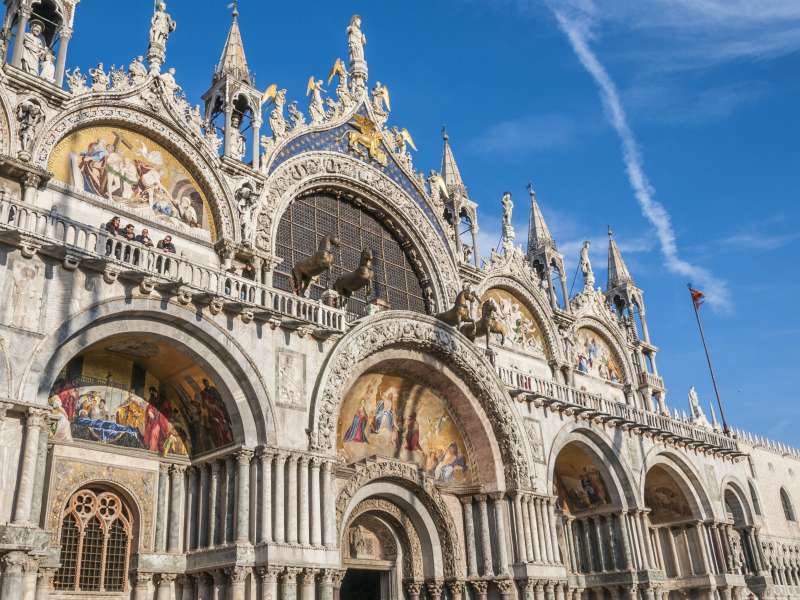
Palazzo Ducale (Doge’s Palace). Adjacent to the basilica, this was the administrative center of Venice. There are the Doge’s apartments and two grand rooms with spectacular art covering the walls – the Sala del Maggior was where the council met and has portraits of many of the doges’ including one traitor covered with black. The Battle of Lepanto is especially noteworthy. The tour ends in the prisons and I felt imprisoned trying to get out of the maze.

 Bridge of Sighs is an enclosed bridge made of white limestone, has windows with stone bars, passes over the Rio di Palazzo, and connects the New Prison (Prigioni Nuove) to the interrogation rooms in the Doge’s Palace. It was designed by Antonio Contino (whose uncle Antonio da Ponte had designed the Rialto Bridge) and was built in 1600.
Bridge of Sighs is an enclosed bridge made of white limestone, has windows with stone bars, passes over the Rio di Palazzo, and connects the New Prison (Prigioni Nuove) to the interrogation rooms in the Doge’s Palace. It was designed by Antonio Contino (whose uncle Antonio da Ponte had designed the Rialto Bridge) and was built in 1600.
The view from the Bridge of Sighs was the last view of Venice that convicts saw before their imprisonment. The bridge’s English name was bequeathed by the British poet Lord Byron in the 19th century as a translation from the Italian “Ponte dei sospiri”, comes from the suggestion that prisoners would sigh at their final view of beautiful Venice through the window before being taken down to their cells. In reality, the days of inquisitions and summary executions were over by the time the bridge was built, and the cells under the palace roof were occupied mostly by small-time criminals. In addition, little could be seen from inside the bridge due to the stone grills covering the windows.
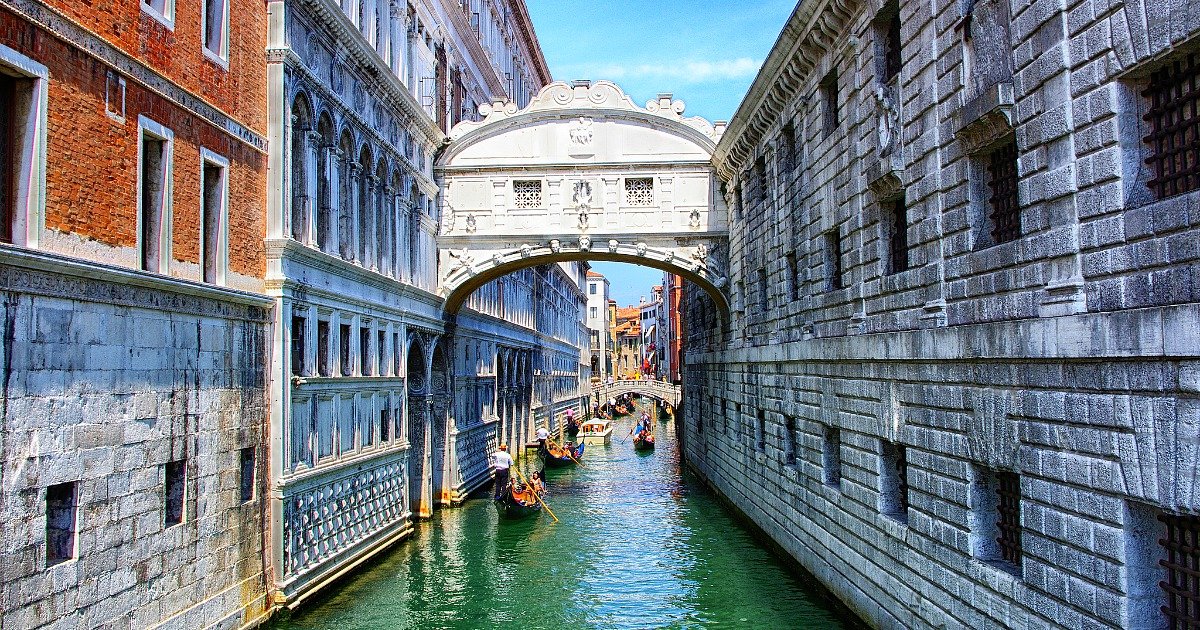 Museo Fortuny or Fortuny Museum is an art museum in San Marco housed in the Palazzo Pesaro Orfei, now often known as Palazzo Fortuny, where Mariano Fortuny (1871–1949) had a studio in the late nineteenth century, and lived from 1902. Fortuny pioneered dying fabrics.
Museo Fortuny or Fortuny Museum is an art museum in San Marco housed in the Palazzo Pesaro Orfei, now often known as Palazzo Fortuny, where Mariano Fortuny (1871–1949) had a studio in the late nineteenth century, and lived from 1902. Fortuny pioneered dying fabrics.
The museum presents paintings, fabrics, and Fortuny’s lamps on the first floor, together with the history of the palazzo and its atelier on the second floor. The building still has features created by Fortuny. The working environment is represented through wall-hangings, paintings, and lamps. The present exhibit was about the future. Off a tiny square, there are no tourists in this part of Venice. €10, €8 reduced
Palazzo Grimani. This was another palace that could not be accessed and had no indication that it is ever open. The facade of marble columns and many heads, has a tiny walkway that was under construction and could not be accessed. The best views may be across the canal.
Santa Maria dei Miracoli (St Mary of the Miracles). This all marble church (inside and out) is the most popular wedding church in Venice as it is closest to a canal. The “miracle” happened well before the church was built when a local drowned in the canal but revived when a tiny painting of Mary holding Jesus was prayed in front of. Because of all heavy marble, it has had subsistence problems. A wedding was about to happen and it was interesting to see Venetian fashion – many long dresses, velvet and fur jackets. Free
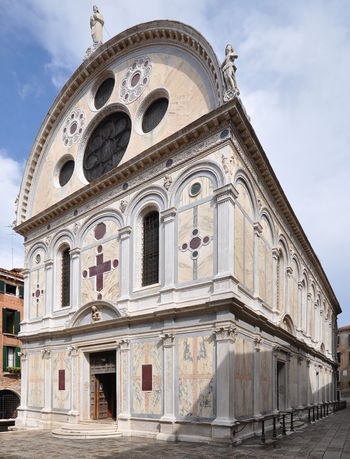
Ca’ d’Oro. Built in classic style, this white marble building is all columns and pink marble window casings. It is not accessible as it is right on the water and the back is stores fronting a busy shopping street.
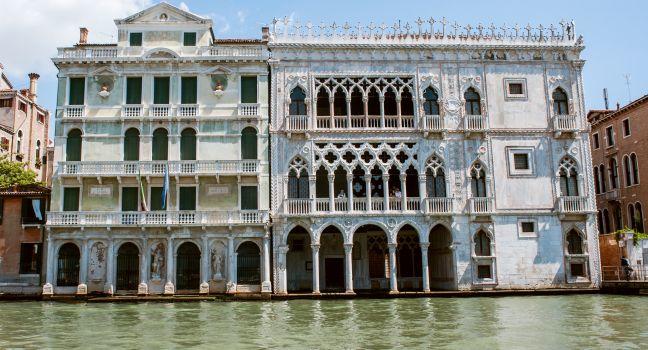 Fondaco dei Tedeschi. The only “shopping mall” in Venice, it is 4 floors surrounding a large central courtyard of very high-end luxury goods – handbags, watches, shoes. To access the terrace for views book a reservation at www.tfondaco.com. Free it was booked out over 24 hours in advance.
Fondaco dei Tedeschi. The only “shopping mall” in Venice, it is 4 floors surrounding a large central courtyard of very high-end luxury goods – handbags, watches, shoes. To access the terrace for views book a reservation at www.tfondaco.com. Free it was booked out over 24 hours in advance.
Rialto Bridge is the oldest of the four bridges spanning the Grand Canal. Connecting the sestieri (districts) of San Marco and San Polo, it has been rebuilt several times since its first construction as a pontoon bridge in the 12th century, and is now a significant tourist attraction in the city. The first dry crossing of the Grand Canal was a pontoon bridge built in 1181. It was called the Ponte della Moneta, presumably because of the mint that stood near its eastern entrance.
The development and importance of the Rialto market on the eastern bank increased traffic on the floating bridge, so it was replaced in 1255 by a wooden bridge. This structure had two inclined ramps meeting at a movable central section, that could be raised to allow the passage of tall ships. The connection with the market eventually led to a change of name for the bridge. During the first half of the 15th century, two rows of shops were built along the sides of the bridge. The rents brought an income to the State Treasury, which helped maintain the bridge. Maintenance was vital for the timber bridge. It was partly burnt in a revolt in 1310. In 1444, it collapsed under the weight of a crowd watching a boat parade and it collapsed again in 1524.
The present stone bridge, a single span, was finally completed in 1591. It is similar to the wooden bridge it succeeded. Two inclined ramps lead up to a central portico. On either side of the portico, the covered ramps carry rows of shops. The bridge has defied its critics to become one of the architectural icons of Venice.
 Mercato di Rialto (Rialto Fish Market). This seafood market is open in the mornings until early afternoon (about 2 pm) and is a few hundred metres north of the bridge on the Gran Canal. It feels like one of the few authentic places in Venice.
Mercato di Rialto (Rialto Fish Market). This seafood market is open in the mornings until early afternoon (about 2 pm) and is a few hundred metres north of the bridge on the Gran Canal. It feels like one of the few authentic places in Venice.
Ca’ Pesaro. Across the Grand Canal from Ca d’Oro, it is a long walk via the Rialto Bridge to get to. The 3-story building has columns and arches. It houses the Gallerie Internationale d’Arte Moderna with a permanent exhibition on the 1st floor, temporary on the 2nd and the Museum of Oriental Art on the 3rd floor. €10, €7.50 reduced

Palazzo Labia. This palace holds the RAI, the Radio Television Italiano offices and is not open to the public. The facade facing the canal has several great heads and cock statues.
PADOVA (PADUA)
TIPS FOR PADUA
1. Padua Viva Ticket. For €17 for 48 hours, this is a good deal as it includes Scrovegni Chapel (€13 + €1 booking fee) and all the museums. The reservation for Scrovegni applies to Zuckerman Palace and the Eremitani Museums – all three are right next to each other in a park in north Padua.
2. Scrovegni Chapel tickets must be reserved, either online or at the Tourist Information at the train station (recommended for many reasons). They cannot be purchased at the site. Even in mid-March, the only ticket available was for 48 hours later. I can only imagine it might be weeks ahead in the busy summer.
I slept in the McDonalds lot in Mestre, one or the best on my trip with fast wifi, great hours (7-1 am) and even electrical sockets which are unusual in Italy. I then drove back to Padua to see everything before my Scrovegni reservation at 6 pm.
In south Padua, there is a wonderful park – an oval moat surrounded by statues and a fountain in the middle. A great flea market was on and I bought a pair of faded Levis with a button fly for €15. They had hundreds of pairs. The first three things surrounded the park.
Benedictine Abbey of Santa Giustina. This monster of a church has plain white walls and pillars but wonderful side chapels full of marble, art and stucco statues. The two chapels next to the apse were special – one had a great fresco ceiling and the other a carved stucco ceiling. The Corridor of the Martyrs had the bones of ancient Christians persecuted for their beliefs. Free
Botanical Garden of Padua University (Orto Botanico). Started in 1545 as a source of medicinal plants in the same site it is today, it is the oldest botanical garden in the world. It was UNESCO World Heritage listed in 1996. There are lots of big trees but few were in leaf and there were no flowers – as in most botanical gardens, all names are genus/species – I would like to see the common names. The Garden of Biodiversity is in a large greenhouse with plants categorized according to origin. The dioramas are very well done discussing several plants that formed the backbone of many cultures: rice, bamboo, flax, sago palm, papyrus and paper production, cotton, hemp, rubber, cacao, tobacco. The herbarium has 6000 species in a large round enclosure. €10, €5 reduced
Museum of Precinema. Not knowing what to expect, this is one of the best little museums I have ever been to. Representing the collection of Minici Zotti, it shows puppetry around the world, lantern projectors, camera obscura and many types of stereoscopic viewers with a brilliant slide collection. Start with a subtitled video and then get a personal guided tour. €6, €4 reduced
MUSME – Museum of Medical History in Padova. Near the town centre, it tells the story of medicine in Padova using interactive exhibits. There is a lot of how the body is structured, works and malfunctions. €10, €8 reduced
Palazzo Zabarello. In a nice palace on the main street, this was a welcome change from all the religious art with good impressionists. €8, no reduction
Palazzo della Regione was built in 1218 with porticos added on both sides 100 years later. It sits between two large squares and has a food market on the ground floor. A tour of the archaeological dig happening in the basement is offered on Tuesdays, Thursdays and Saturdays at 11,12, 3 and 5. The Salon on the first floor is 81m x 27m by 27m high (the ceiling is a long barrel vault and is frescoed.
I then went to the three civic museums all grouped together near a park, included in the Padua Viva ticket. Most of the labels are in Italian.
Palazzo Zuckerman. This houses both the Museum of Applied and Decorative Arts (furniture, coins, pottery, porcelain, jewellry, lace) and the Museo Bottacin, a wealthy Paduan and his summer home in Trieste (coins, furniture, art).
Eremitani Museum. In the former Augustinian Hermits monastery, it shows the archaeology of Padua, there are exhibits on Romans, Etruscans, Greeks, Egypt and a lot of 14th to 18th century art, almost all religious on the upper floor.
Scrovegni Chapel. After the Botanical Garden, this is the highlight of Padua.
in 1301, the rich nobleman, Ernich Scorvengi, built a townhouse in the area of the Roman arena and a chapel. He commissioned the Tuscan master, Giotto to decorate the chapel with frescoes between 1303-05. He also had Giovanni Pisano make the sculptures on the altar. Today, the frescoes are entirely preserved showing the stories of the Virgin Mary and Jesus on the walls ending with the impressive fresco of the Last Judgement.
Visitors enter a special room 15 minutes before entering the chapel in order to stabilize the temperature and humidity in the chapel, which is visited for another 15 minutes.
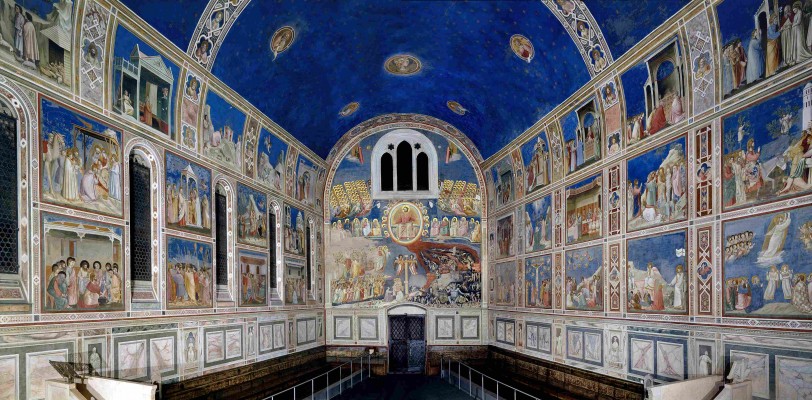
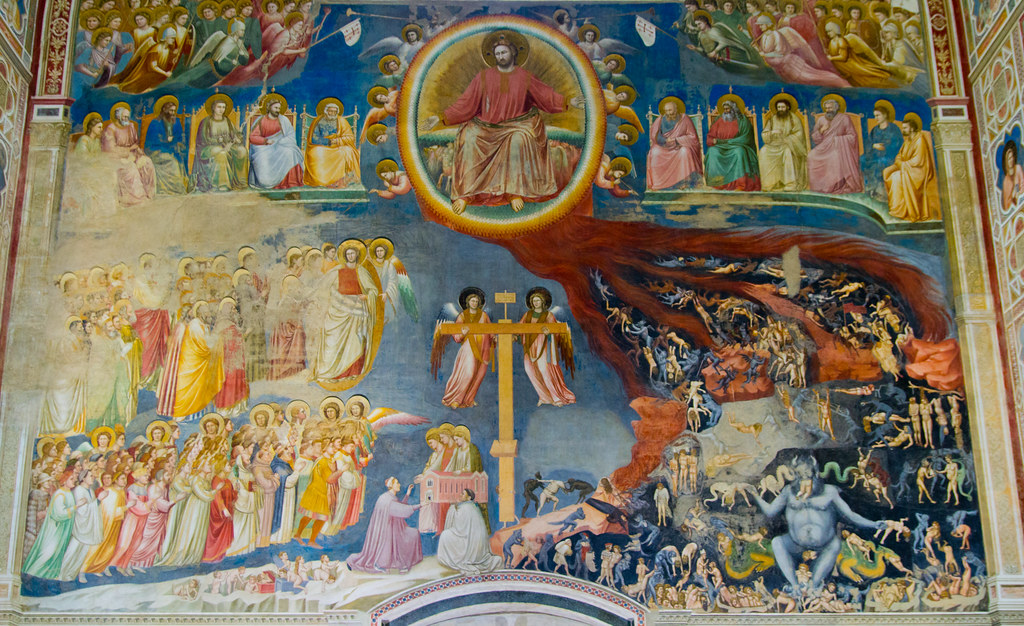
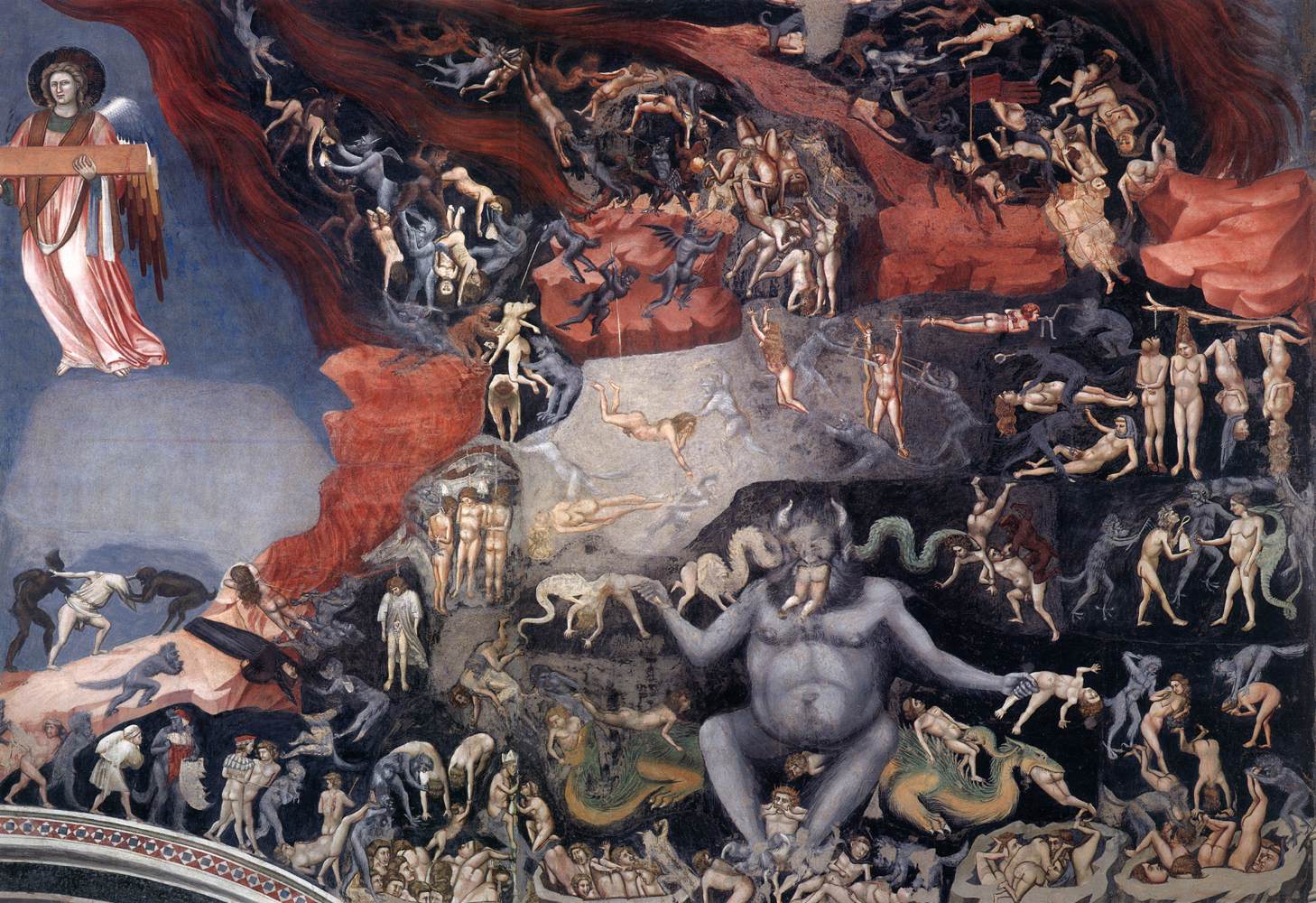

Portogruaro. Another nondescript NM “small town, this is quite a big place with a long access off the main highway. It was the last place I visited in Veneto.